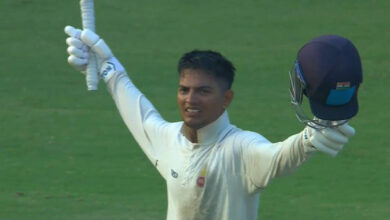How Kohli and Pujara’s issues against spin can be exploited Australia in the Border-Gavaskar Trophy

After the heroic last-ball, last-wicket, last-session draw New Zealand squeezed out in Kanpur the year before, Rahul Dravid handed curator Shiv Kumar a cheque of Rs 35,000. The coach was not exactly pleased with the surface Kumar had put together—“the turn was low and slow, did not wear and tear,” he would complain—but found joy in the crowd getting to watch a game that lasted a full five days. “It had everything a Test match could offer, quality cricket as well as drama. The match was alive till the final ball, which is a victory for Test cricket.”
A Test match lasting all five days in India is an utter rarity in India. Since Australia’s trenchant draw in Ranchi, in 2017, it has happened just thrice in 18 games, one of which was a rain-curtailed one in Eden Gardens. From 2021, the average days-span of a Test match has been 3.6 days. The much-maligned villain of the piece has been the pitch, the raging, kinking turners, where the skilled and shrewd spinners have woven an artful web of infallibility. Their numbers bewilder—Axar Patel has gobbled up 39 sticks at 12.83, Ravi Ashwin 58 at 13.98 and Ravindra Jadeja, who missed the England series due to an injury 15 at 16.
Kohli’s lbw fear and Pujara’s troubles against left-arm spinners
But in the result-driven, advantage-stretching, supremacy-setting quest, two of India’s most prolific contemporary batsmen have withered in their own climes, the same climes that nursed and nurtured them. In this span. Virat Kohli, undoubtedly the leading light of this generation, averages 23.25; the second most experienced one, Cheteshwar Pujara, aggregates 22.80. This is not an accusation that they have forgotten to play spin bowling, not with 8119 and 7014 runs, a collective haul of 46 Test hundreds. But in the final passage of their career, the two stalwarts of Indian cricket have stumbled onto an unusual nemesis, spin bowlers on subcontinental surfaces.
In 11 of Kohli’s 15 outings in Asia, a spinner has devoured him, six times left-arm spinners and on five instanced off-spinners. Similarly, 10 of Pujara’s 14 excursions have ended in the hands of a spinner, eight times left-arm spinners and twice off-break practitioners. There were some freak dismissals, like Cheteshwar Pujara’s full-bloodied pull thudding off the short-leg fielder’s back and looping in the air in the first Test against England, or Virat Kohli undone a shooter in Bangalore against Sri Lanka. There were some genuinely unplayable deliveries too. One that leapt off the rough, one that ripped off the surface. Such aberrations aside, most of the dismissals stemmed from flawed judgement.
The lbw fear spooks Kohli. Moeen Ali probably sowed the doubts in the second innings of the second Test against England in Chennai. Kohli was batting sumptuously when he hung back and tried to work the ball off his legs. Ali was bowling around the stumps and so Kohli shuffled a fraction more across than he tends to, but missed the ball altogether and was nailed in front. Thereafter, whether he was duelling a left-arm spinner or an off-spinner, he would be in two minds. Whether to press forward or hang back. In this exential confusion of batsmen, he would often be neither here nor here. Ali cut the wound open again, in the second innings in Oval, when he made the ball hold the line, probably a natural variation, to have him nicked at first slip.
Thereafter, his suspicion on his spin-playing ability became a worm inside his head. A raft of nondescript bowlers, from Ajaz Patel to Lasith Embuldeniya and Dhananjaya de Silva preyed on his wounded mind. Now the perceived weakness mutated into a real one. It fully manifested in Bangladesh, where he would experiment with his stance – shifting from middle to leg-stump guard – and trigger movement but with little change of fortune.
Whatever happened to once strong back-foot play, where he would just shift back and work the ball through the off-side or down the ground. He still does move back, but instead of showing the full phase, he closes the bat face. Kohli, of course, has tamed such beasts in the past, like the mastering of James Anderson in 2018. How he overcomes his latest flaw would be an enthralling storyline. His encounters against Nathan Lyon has the potential to be the tour de force of the series.
The spin vulnerability of Pujara was the exact opposite in nature of Kohli’s. He was taunted the left-armer’s stock ball, the away-goer. He has a tendency to just thrust his front-pad, a half-press rather, with the bat behind the pad, suggesting his intention to leave the ball untouched. It’s a method that has benefited him. The bowler would then would then start bowling at his stumps and he would just work it through the leg-side. But sometime during the England series, he started getting sucked into the inward angle, sometimes drift, of Jack Leach. When the ball suddenly turned away, he would grope with a slightly angled bat-face and edge. Another habit too winked in, he started playing from the crease rather than stepping out, which often landed him in no man’s land. But Pujara, the survivor that he is, kicked away the bad habits in Bangladesh. More definitive with his footwork, more assertive in his stroke-play, he rediscovered his touch in Bangladesh, showed how a calm assessment and concentration can work, and ended his nearly three-year-long century drought.
Nonetheless, there are imperfections in the spin-game of India’s two most prolific run-getters of this era, making them the perfect fall guys for old-timers to lament about contemporary Indian batsmen’s ineptness against spin. It was not like turners were nonexent in the 80s, 90s and the aughts, not like there was a paucity of quality spinners. Probably, there were better spinners, two of the all-time greats, in Shane Warne and Muttiah Muralitharan, besides nearly-great ones like Saqlain Mushtaq and Mushtaq Ahmed.
But Saqlain apart, no one prospered in India. Muralitharan averaged 45.45, double his overall number, Shane Warne’s corresponding number is 43.11 Twinkled-toed, velvet-handed batsmen with rubbery hands, would whimsically, instinctively destroy them.
Their successors, perceptibly, are not as proficient. Yet, evidence has been tumbling out of the cupboard, even in white-ball formats, where India batsmen tw their face at the sight of a turner. Touring spinners do descend with a whiff of hope, unlike the no-hopers of the 90s or the aughts. Not without reason, as they have unearthed success. Just that whatever they do, Indian spinners out-do them. Steve O’Keefe spun Australia to a famous win in Pune; both he and Nathan Lyon grabbed 19 wickets apiece; the bespectacled Jack Leach scythed them in Chepauk; Ajaz Patel grabbed an innings 10-for, latest, Bangladesh’s spinners unleashed mayhem in the recent Test series.
The absence of Pant and Shreyas
Worse, India would be without their two most destructive batsmen of spin bowling in the middle order, Rishabh Pant and Shreyas Iyer. Without Pant’s heroics, England could have squared the series, and without Iyer’s assuredness, both New Zealand and Sri Lanka could have pushed for a victory.
Iyer’s replacement Suryakumar Yadav has been masterly against spinners in the shorter versions as well as in domestic cricket, but he is untested at this level. The promise he possesses is immense—honed in the classical Mumbai school of batting against spin. He does step out, has an assortment of sweeps and unpacks the slog, an ungainly but precious weapon on turners, one even Sachin Tendulkar often resorted to. Pant’s potential replacement KS Bharat is more of an old-school accumulator, and an unknown on turners. Up the order, KL Rahul was dodgy against the spinners in Bangladesh, though his heroics of the past fill hope.
Even Rohit Sharma, whose 161 at a Chepauk was a textbook innings on nullifying spinners on a turning track, has not been consent against spinners. Though he is arguably the most natural player of spin bowling in the top-six, and the best sweeper in the team, left-arm spinners have not left him unharmed. The last five of his nine dismissals in Asia were masterminded the ilk (Leach 4, Embuldeniya 1). So he is not foolproof to spin vicissitudes either.
It holds true for the whole team, it’s the left-arm spinners that have surfaced as the tormentors. Of the 105 Indian wickets spinners have captured since the tour of England, left-armers have accounted for 67. It could be that there are more left-arm spinners around than leg-spinners or off-spinners, nonetheless it is no coincidence that a left-spinner was the wrecker in chief in the three of India’s last four home defeats (2012 Mumbai, 2017 Pune, and 2021 Chennai). Interestingly, none of them have been the modern-day stump-to-stump flat-trajectory merchants, but more old-school operators, tossing, drifting and dropping the ball. Only one among the quartet Australia have packed for India is a left-arm spinner—Ashton Agar, whose Test career has been erratic. But so have been the career trajectories of Monty Panesar, Steve O’Keefe and Jack Leach.
Hence, perhaps, the apprehension that the turner-ploy could bite back. But supreme reigns the belief that what Lyon and Co. could do Ashwin and Co could out-do, indirectly ensuring that a Test that lasts a full five days remains a rarity. And when a spectacle such as that occurs, the curator gets rewarded.







